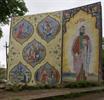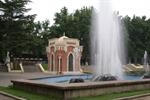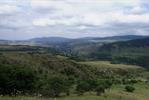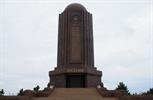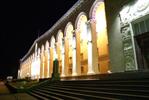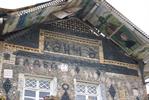Ganja is Azerbaijan's second city with a population of nearly 300,000. A 'Ganja kiss', like the Glasgow equivalent, is in fact a head-butt. But the caricature of short-tempered citizens is exaggerated. Very few people have heard enough Jamaican English to realize the funny side of the town's name nor the irony that Hash (Xash) is a local delicacy.
Ganja makes a logical base for touring the lovely mountains and forests of the Lesser Caucasus. Its pleasantly calm city centre has several mosques and churches (most now disused or converted into theatres), an imposing Stalinist city hall, the former National parliament building and the quaintly kitsch 'bottle house'.
Despite a certain Soviet grandeur, the main touristic reason to come to Azerbaijan's pleasant second city is as a staging post for Xanlar and Goy-Gol. Today Ganca lags very considerably behind the capital in almost all senses. Yet, as it self-indulgently celebrated in 2006, the city has 25 centuries of history behind it and was formerly a much more important cultural centre than Baku. Most proudly it was home to the national bard Nizami Gancavi (1141-1209).
What to see
The vast, central Heydar Aliyev (former Lenin) Sq is lined by powerful Stalinist architecture, notably the arcade-fronted City Hall and the grand Hotel Ganca. Towards the square's southern end the old hammam now hosts a small, rather tacky porcelain gallery near the twin-minareted 1620 Juma Mosque.
The central square has a rough patch of paving where a giant Lenin once stood. It is dominated by the Stalinist arches of the grand city administrative buildings built in 1948-9 by architects Ismailov and Leontieva. The Soviet insignia over the doors at each end have been painstakingly replaced with Azeri national symbols. The rest of the facade, however, retains good old communist-era motifs - tractors, helicopters, bridges and industrial scenes topped off with flag designs/
The 17th-century Abbas (Juma) Mosque in the central square is a modest brick affair with two minarets but has an attractive domed interior. Outside an ancient hollow Chinar tree is bricked up for support. A former mosque behind the historical museum is now used as a gallery.
From here you could stroll Cavadxan kuc, the city centre's almost-quaint pedestrian lane, or explore some appealing patches of wooded parkland that twinkle at night with (male-dominated) chayhanas.
East of town is the 1991 Nizami Mausoleum (Baku Hwy; admission free), a space shuttle-shaped tomb-tower flanked by a series of inspired sculptures depicting scenes from Nizami's works. A vast aluminium smelter forms an incongruous backdrop.
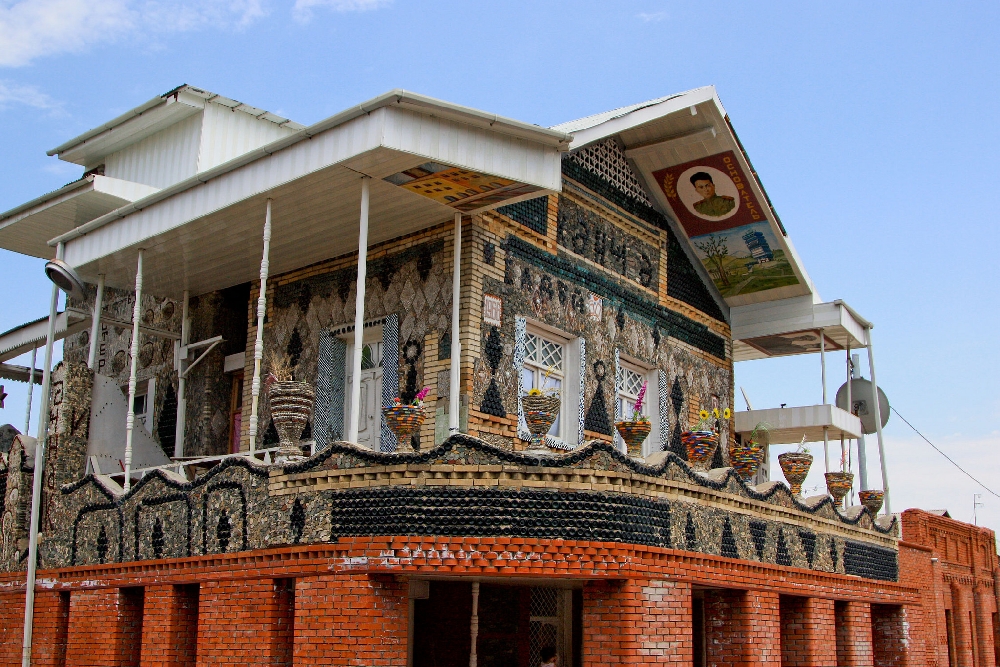 The Bottle House (15 Guseinli) is one of Ganja's more off-beat attractions. More impressive than its more famous relative in Rhyanon, Nevada, it's the work of Ibragim Jaffarov who used 48,000 glass bottles to decorate an existing two-storey home. Though the use of bottles was purely aesthetic, the pictures on the gables commemorate Ibragim's brother Yusif (the portrait that looks like Mao). Yusif never returned from WWII. He didn't die as the family received a mysterious letter from him in 1957 but have received no word since. The prominently painted word '†¤Ґ¬' (Zhdem) means 'we wait for you'. Visitors are encouraged to buy something from the motley selection of overpriced gum, beer and Snickers bars sold from the porch of the house by Ibragim's son to finance the house's much-needed renovation.
The Bottle House (15 Guseinli) is one of Ganja's more off-beat attractions. More impressive than its more famous relative in Rhyanon, Nevada, it's the work of Ibragim Jaffarov who used 48,000 glass bottles to decorate an existing two-storey home. Though the use of bottles was purely aesthetic, the pictures on the gables commemorate Ibragim's brother Yusif (the portrait that looks like Mao). Yusif never returned from WWII. He didn't die as the family received a mysterious letter from him in 1957 but have received no word since. The prominently painted word '†¤Ґ¬' (Zhdem) means 'we wait for you'. Visitors are encouraged to buy something from the motley selection of overpriced gum, beer and Snickers bars sold from the porch of the house by Ibragim's son to finance the house's much-needed renovation.
Museums
The History Museum (Tue Sun, 11-17:00) is housed in the former mansion of the Zhiadkhanov brothers who were among the founders of the 1918 Democratic Republic. Exhibits include a model of how the ancient city may once have looked plus all the usual photos, mammoth bones and Kupe amphorae. In the garden behind are a selection of old stone rams and horses and to the side a renovation workshop.
The 1918 Parliament convened initially in the building that's now the Agricultural Academy (closed to the public). Across the road is the Academy Museum (Akademiyanin Muzeyi) which formed the parliamentary annex at the same time. While there's some duplication with the History Museum, this is a brighter more interesting version thanks in part to the old bronze and white-tiled fire places and the overpoweringly gaudy Nizami room painted by Rustam Guseinguliev with scenes from Khamza and multilingual translations of Nizami's aphorisms. Entry is free.
Other curiosities
Though quite large, the supposedly 17th-century brick caravanserai is relatively unspectacular, though there's added interest from souvenir and art shops plus a small gallery set into the facade. The inner courtyard is graced by a massive plane tree, but is part of the Ganja State Humanitarian college and not officially open to the public.
It is pleasant to stroll in the city park, though the remnant sections from the old Russian fortress are utterly underwhelming. Of Ganja's several churches, the most elegant is a gutted Armenian 1869 drum-towered edifice set almost invisibly amid houses off the main road to Xanlar. To get in requires climbing over a high metal gate. An unmarked building right beside the church (at 56 Tagiev St) is a carpet factory for creating portrait carpets. It's fascinating to visit. To get your own photos made into carpets bargain very hard - opening bids are about $500/per square metre'.
Ancient Ganja and the Nizami Mausoleum
Modern Ganja has moved with the shifting course of the Ganja River. The original site is some 5km east of the present centre. Archaeologists have found a few scrappy flint and mortar walls but most of the site is now on military land with little to see even if you are allowed in.
The main visitable attraction is the Nizami Mausoleum which is relatively elegant but dates only from 1991, replacing a 1947 version.
The soaring 22m-high structure is sombre and simple, but the marble on the walls is a thin veneer which doesn't appear to be built to last. Behind the mausoleum, some scenes from Nizami dramas are depicted in metal reliefs with the jarring backdrop of a huge aluminium smelter. Driving along the main road through the underpass beneath the mausoleum don't be alarmed if the car behind starts sounding his horn - some locals 'hoot for Nizami'.
If you're planning a trip to Azerbaijan you may be interested ▶ Azerbaijan highlights - For those who prefer to go unbeaten path, to explore less visited places and check national charisma of this small country in Southern Caucasus on the edge of Europe.




